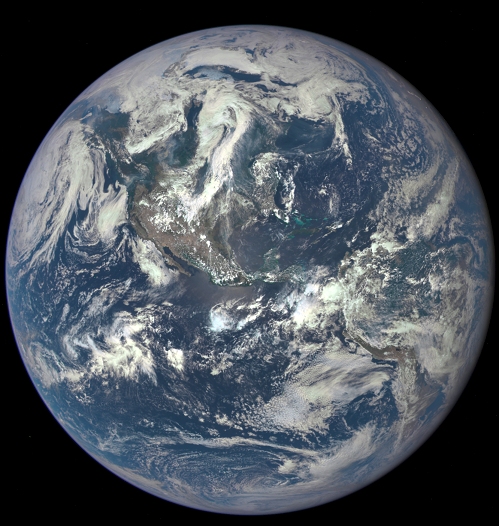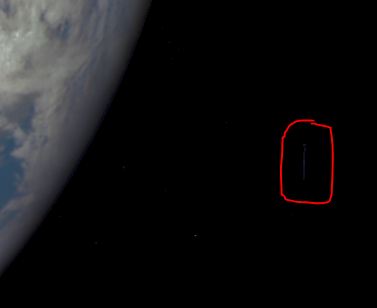It looks like you're using an Ad Blocker.
Please white-list or disable AboveTopSecret.com in your ad-blocking tool.
Thank you.
Some features of ATS will be disabled while you continue to use an ad-blocker.
share:
NASA have posted quite an epic and evocative image today - our planet as seen by the
Deep Space Climate Observatory from one million miles away.

This reminds me of the view of Earth Apollo astronauts had on their way to the Moon. The spacecraft is actually almost 4 times more distant from Earth than the Moon is, orbiting a point between Earth and the Sun called L1 Lagrangian point.
Source and full-size image: www.nasa.gov...

This color image of Earth was taken by NASA’s Earth Polychromatic Imaging Camera (EPIC), a four megapixel CCD camera and telescope. The image was generated by combining three separate images to create a photographic-quality image. The camera takes a series of 10 images using different narrowband filters -- from ultraviolet to near infrared -- to produce a variety of science products. The red, green and blue channel images are used in these color images.
This reminds me of the view of Earth Apollo astronauts had on their way to the Moon. The spacecraft is actually almost 4 times more distant from Earth than the Moon is, orbiting a point between Earth and the Sun called L1 Lagrangian point.
Source and full-size image: www.nasa.gov...
Well that is a cool pic! Thanks for the share!
I have to say, after blowing it up, I am wondering how this long blurred line occurred with it being a series of images.

That is near the lower right of the pic. It is the only blurred line and I would think that could only occur if it was a long shutter release, yet none of the stars in the background exhibit this motion blur.
I have to say, after blowing it up, I am wondering how this long blurred line occurred with it being a series of images.

That is near the lower right of the pic. It is the only blurred line and I would think that could only occur if it was a long shutter release, yet none of the stars in the background exhibit this motion blur.
edit on 7/20/15 by Vasa Croe because: (no reason given)
Great details from that distance.
I wonder how far the sats from pluto and ceres are? Just to compare distance and detail.
I wonder how far the sats from pluto and ceres are? Just to compare distance and detail.
a reply to: wildespace
Figures. Another composite image. This proves they're lying to us. The earth is flat, and at the center of the universe.
Figures. Another composite image. This proves they're lying to us. The earth is flat, and at the center of the universe.
edit on
7/20/2015 by Klassified because: Oops. Replied to OP instead of Network Dude.
originally posted by: Vasa Croe
Well that is a cool pic! Thanks for the share!
I have to say, after blowing it up, I am wondering how this long blurred line occurred with it being a series of images.
That is near the lower right of the pic. It is the only blurred line and I would think that could only occur if it was a long shutter release, yet none of the stars in the background exhibit this motion blur.
Wait for it, wait.... ALIENS!
Thta's amazing. Space is such an interesting place to explore. Never ending discoveries are out there waiting for us. If we could only sort out the
problems on our planet, we could work together exploring the vastness of space. Star Trek style.
Fantastic Image. So clear.
Fantastic Image. So clear.
originally posted by: slapjacks
originally posted by: Vasa Croe
Well that is a cool pic! Thanks for the share!
I have to say, after blowing it up, I am wondering how this long blurred line occurred with it being a series of images.
That is near the lower right of the pic. It is the only blurred line and I would think that could only occur if it was a long shutter release, yet none of the stars in the background exhibit this motion blur.
Wait for it, wait.... ALIENS!
That's the edge of the dome.
The image was generated by combining three separate images to create a photographic-quality image.
There has never ever been 1 picture of Earth from space, can't they take just 1 picture and show that without editing it.
originally posted by: NeoSpace
There has never ever been 1 picture of Earth from space, can't they take just 1 picture and show that without editing it.
Not true. In any case, here you go, here is a picture of the earth taken from space. I even have the original print.
Beautiful planet, thankful for the ultra rare probability to be birthed here in Earth.
Not thankful the species I was born into is hell bent the wrong wrong..
We take for granted everything these days, dismiss our totality connection with each other, the planet the cosmos.. such things were vital and so dear to our ancestors hearts.
To think; breathing, living, alive here on earth is one of the most rarest experiences within the universal creation.
Such can only be a possibility under specific and extreme circumstances.
And here we are, on that beauty ♡
Not thankful the species I was born into is hell bent the wrong wrong..
We take for granted everything these days, dismiss our totality connection with each other, the planet the cosmos.. such things were vital and so dear to our ancestors hearts.
To think; breathing, living, alive here on earth is one of the most rarest experiences within the universal creation.
Such can only be a possibility under specific and extreme circumstances.
And here we are, on that beauty ♡
originally posted by: Vasa Croe
Well that is a cool pic! Thanks for the share!
I have to say, after blowing it up, I am wondering how this long blurred line occurred with it being a series of images.
That is near the lower right of the pic. It is the only blurred line and I would think that could only occur if it was a long shutter release, yet none of the stars in the background exhibit this motion blur.
I've seen that before!
Wait... was it Superman, first movie??
Here is close up...
On serious side, really cool image of Earth. Wonder what would image look without telescope...
a reply to: NeoSpace
Seriously where have you been?
Never mind all the Apollo ones, you have the Russian ones, the ones taken by Voyager, by China, by Japan, even this one from 1967:

Taken by a geostationary satellite.
There are hundreds of photographs of Earth.
Seriously where have you been?
Never mind all the Apollo ones, you have the Russian ones, the ones taken by Voyager, by China, by Japan, even this one from 1967:

Taken by a geostationary satellite.
There are hundreds of photographs of Earth.
What a beautiful planet, and it could be such a lovely place to live, filled with promise. It's such a shame about its current inhabitants. They must
be utterly clueless about the gift that is under their feet and the adventure that hovers over their heads.
a reply to: onebigmonkey
Nice 1967 picture. Look how deep blue the ocean looks compared to the OP's picture, where the oceans look pale light blue. I hope that's just a photo optics thing, and not that the atmosphere has changed so much in the intervening years that its reflection on the water gives off a paler color.
Nice 1967 picture. Look how deep blue the ocean looks compared to the OP's picture, where the oceans look pale light blue. I hope that's just a photo optics thing, and not that the atmosphere has changed so much in the intervening years that its reflection on the water gives off a paler color.
NASA just posted the following:
Looks like this photo is making quite the waves, and rightfully so.
Veteran astronaut Buzz Aldrin, and current one-year crew member NASA Astronaut Scott Kelly, each have unique perspectives on the importance of the Blue Marble image captured by the National Oceanic and Atmospheric Administration (NOAA)'s #DSCOVR spacecraft.
As Buzz Aldrin was one of the first humans to walk on the Moon, he reflects on how far we have come and what this technology could mean for the future of space travel and our #NextGiantLeap: go.nasa.gov...
NASA Astronaut Scott Kelly, who is currently aboard the International Space Station, explains the important purposes of the DSCOVR mission. “In addition to providing useful data to scientists and researchers, these images will remind all of us that we live on a planet, in a solar system, in a universe. And that we are not just Americans, but citizens of Earth.” Read more: go.nasa.gov...
Looks like this photo is making quite the waves, and rightfully so.
edit on 20-7-2015 by wildespace because: (no reason given)
gorgeous image and helps those with eyes to see how we are all just one people hanging off a very small rock in a VERY
large ocean.
large ocean.
a reply to: onebigmonkey
That is a beautiful painting! It's amazing how much the color of the ocean changes from photo to photo.
That is a beautiful painting! It's amazing how much the color of the ocean changes from photo to photo.
originally posted by: Vasa Croe
Well that is a cool pic! Thanks for the share!
I have to say, after blowing it up, I am wondering how this long blurred line occurred with it being a series of images.
That is near the lower right of the pic. It is the only blurred line and I would think that could only occur if it was a long shutter release, yet none of the stars in the background exhibit this motion blur.
FotoForensics of Earth I put this picture through an analysis site, follow the link to see it and go to where you had circled, wtf is that?

edit on 20-7-2015 by iDope because: added pic
a reply to: wildespace
The main problem I have believing this image is the cloud coverage and that it is a composite. The clouds for one are clearly ridiculous on this day the photo was supposedly taken. You want me to believe that the only land mass visibly seen is Baja and part of SoCal? Look at the clouds over Mexico and Southern Countries, it seems the clouds are perfectly placed to cover the land, and then South America is totally blanketed by a huge cloud system, lol, what a joke.
The main problem I have believing this image is the cloud coverage and that it is a composite. The clouds for one are clearly ridiculous on this day the photo was supposedly taken. You want me to believe that the only land mass visibly seen is Baja and part of SoCal? Look at the clouds over Mexico and Southern Countries, it seems the clouds are perfectly placed to cover the land, and then South America is totally blanketed by a huge cloud system, lol, what a joke.
new topics
-
Shane Gillis commercial
Jokes, Puns, & Pranks: 3 hours ago -
Elon Says It’s ‘Likely’ He Buys Tanking MSNBC
Political Ideology: 5 hours ago -
Montelukast affects brain, caused 5 year old to attempt suicide
Medical Issues & Conspiracies: 6 hours ago -
Jaguar Rebrand Video Causes "WTF?" Moment - Seriously Weird
Automotive Discussion: 8 hours ago -
Let's start a conspiracy
General Conspiracies: 9 hours ago
top topics
-
Biden's "Reckless" Decision To Escalate Russia-Ukraine War
World War Three: 13 hours ago, 16 flags -
Elon Says It’s ‘Likely’ He Buys Tanking MSNBC
Political Ideology: 5 hours ago, 15 flags -
Jaguar Rebrand Video Causes "WTF?" Moment - Seriously Weird
Automotive Discussion: 8 hours ago, 14 flags -
Montelukast affects brain, caused 5 year old to attempt suicide
Medical Issues & Conspiracies: 6 hours ago, 13 flags -
What Joe Rogan said Vs The View
Dissecting Disinformation: 12 hours ago, 11 flags -
Shane Gillis commercial
Jokes, Puns, & Pranks: 3 hours ago, 4 flags -
Let's start a conspiracy
General Conspiracies: 9 hours ago, 1 flags
active topics
-
International Criminal Court Issues Arrest Warrant For Netanyahu
Mainstream News • 41 • : JJproductions -
Elon Says It’s ‘Likely’ He Buys Tanking MSNBC
Political Ideology • 62 • : cherokeetroy -
President-Elect DONALD TRUMP's 2nd-Term Administration Takes Shape.
Political Ideology • 229 • : WeMustCare -
On Nov. 5th 2024 - AMERICANS Prevented the Complete Destruction of America from Within.
2024 Elections • 158 • : WeMustCare -
Post A Funny (T&C Friendly) Pic Part IV: The LOL awakens!
General Chit Chat • 7813 • : watchitburn -
President-Elect TRUMP Picks Former Florida A.G. PAM BONDI to be U.S. Attorney General.
2024 Elections • 44 • : baddmove -
-@TH3WH17ERABB17- -Q- ---TIME TO SHOW THE WORLD--- -Part- --44--
Dissecting Disinformation • 3349 • : 777Vader -
Here is why Western leaders in NATO have zero fear of nuclear warfare. At all. Zero.
World War Three • 8 • : tomeville -
The Acronym Game .. Pt.4
General Chit Chat • 979 • : JJproductions -
What Joe Rogan said Vs The View
Dissecting Disinformation • 20 • : watchitburn
